A ‘game changer’ for immigrants: Job-ready college classes in their native language
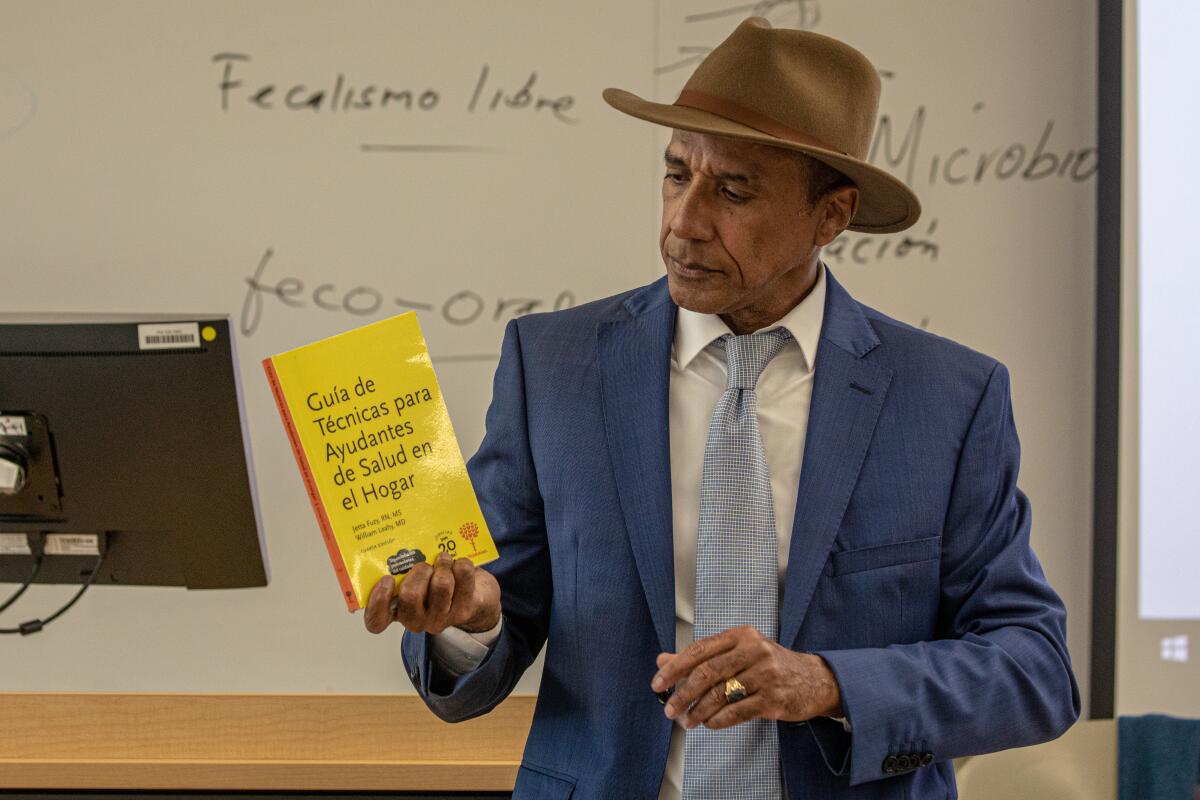
- Share via
When a friend asked Andrea White Rubio if she was interested in caring for an 84-year-old man with early dementia and diabetes during the pandemic, she considered her job options. She had scrambled for months, working as a fruit vendor or going door to door selling shoes from a catalog.
She agreed and, after two years on the job, found a new calling.
“I have always had direct contact with people, but this time my mission was to be able to help people, many whose families cannot help,” the 50-year-old said. “I think God put me on that path.”
That’s how Rubio found herself in a classroom at Los Angeles City College on a recent Friday, learning how to become an in-home support worker. But there was something distinct about this class: It was taught entirely in Spanish.
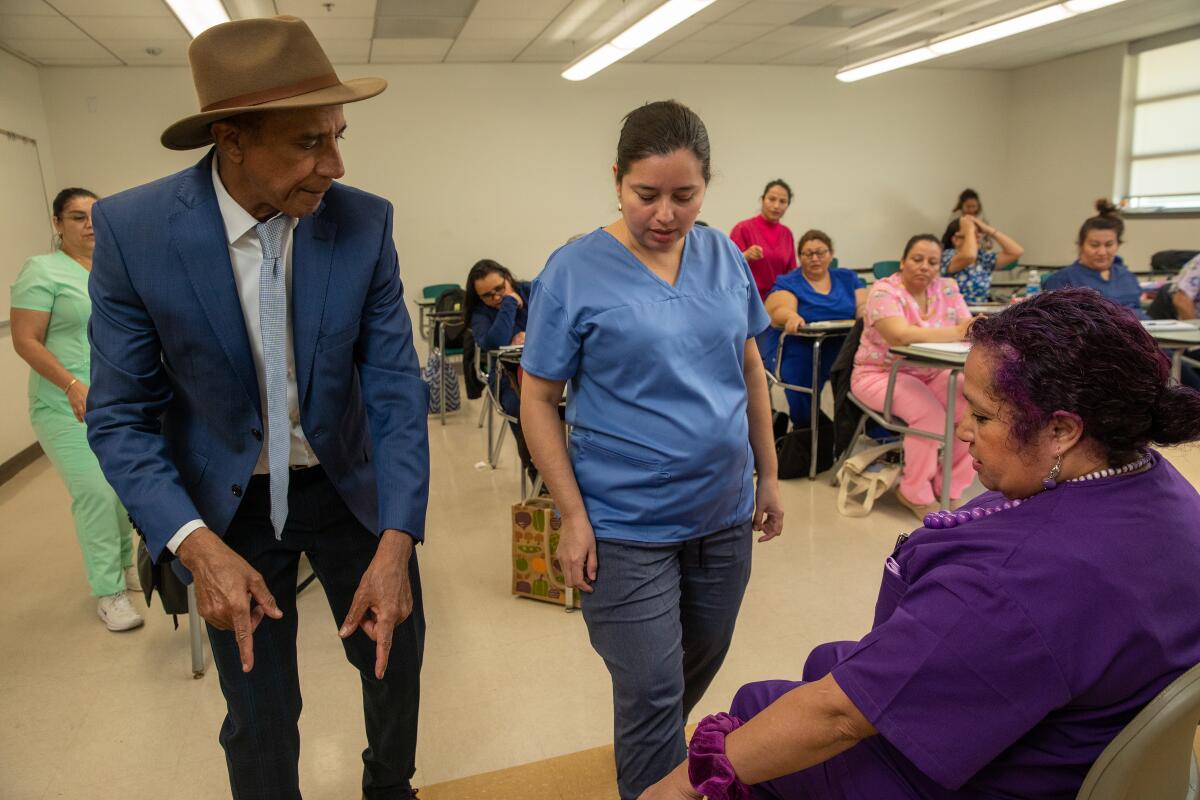
In a move to boost sagging community college enrollment and address student demand for job-ready education opportunities, Los Angeles Community College campuses are experimenting with a new genre of courses taught in the native language of students — Spanish, Korean, Russian. Students can take courses to become automotive technicians, or improve their understanding of child development and keyboarding skills.
The college in East Hollywood is among seven campuses that have expanded such courses this spring, tripling the number to 63 over a year ago.
In 2016, California eliminated a two-decade-old law barring schools from offering bilingual instruction. But such instruction has seldom made its way into higher education. Teaching classes in another language — rather than a bilingual course in which half the instruction is taught in English — is still relatively uncommon, said Yasuko Kanno, chair of the language and literacy education department at Boston University.
Many adult immigrants who are not proficient in English might want to get job training or certification in college but are prevented from doing so because of language barriers, she said. Taking those classes in their own language broadens work opportunities and can prepare them for jobs in their own communities.
“For adult immigrants, this is really a game changer,” she said, adding she is not aware of any statistics that track how many colleges provide content courses in languages other than English.
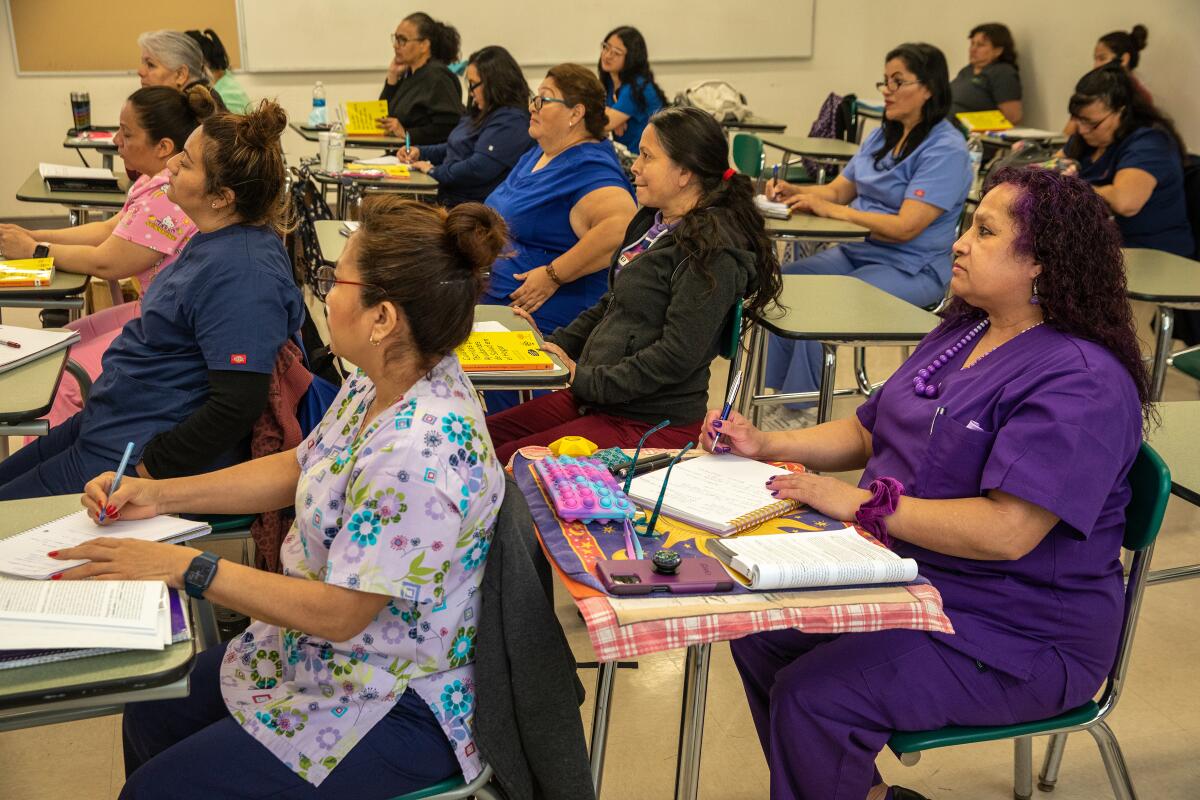
For now, the Los Angeles Community College District is offering non-English instruction only for courses that don’t count toward credit for an associate’s degree — vocational classes in which students can earn certificates in a trade, or classes that prepare them for a GED.
The hope is to one day offer classes required for an associate’s degree in languages other than English, said Gabriel Buelna, a member of the district’s board of trustees.
“We’ve always been a multilingual society in California,” he said. “We’re stuck in education policies that say English-only. We’re beginning the process in community colleges of redefining the relationship between language and higher education.”
In 2006, the state community college chancellor issued a memo that said community colleges may offer classes in non-English languages to students who are not proficient if they are also enrolled in an English acquisition class.
Buelna said it is unclear if the state would help subsidize for-credit classes taught in languages other than English. The district is also trying to determine if credits from classes taught in non-English languages would transfer to four-year colleges and universities.
In the Los Angeles district, the new “in-language” classes are tuition-free, with students only paying the cost for books and other materials.
The community college district is taking the issue up with state lawmakers — Assemblymember Mike Fong (D-Alhambra) is sponsoring a bill on behalf of the district that would authorize community colleges to offer courses taught in languages other than English without requiring students to simultaneously learn English.
Buelna said the demand for non-English classes is clear. In survey responses from more than 2,500 students, 74% said they spoke Spanish at home and 66% said they are interested in taking courses not taught in English.
About 55% of students who participated in the survey were Latino, and nearly 60% were first-generation students. About 60% of students in the district are Latino, 9% are Black, 6% are Asian and 2% are multiethnic, according to state data. The district also educates mostly first-generation students.
Patricia Gandara, a research professor of education at UCLA, said she is not aware of any legal restrictions that would prevent community colleges from providing instruction in languages other than English.
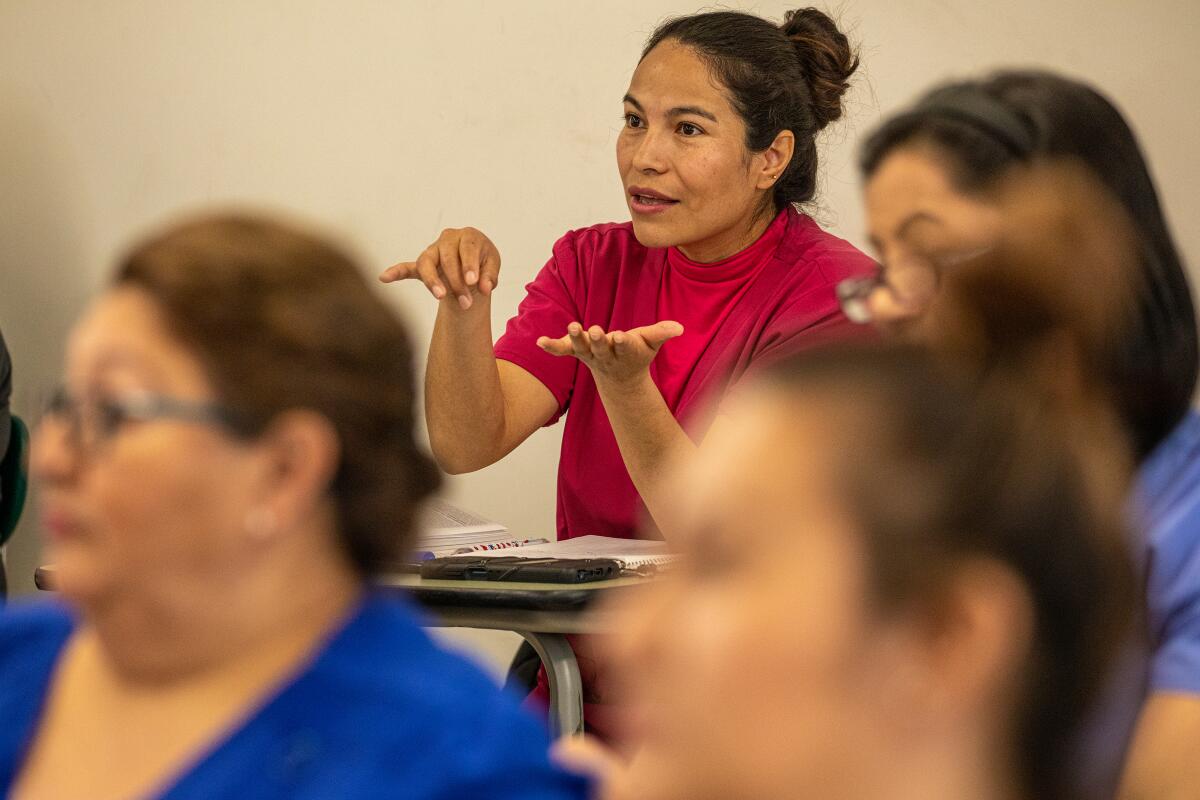
She once supervised a UC Davis doctoral student from Mexico who completed his dissertation in Spanish.
“If a student’s stronger language can be used, that increases their understanding of what is going on,” Gandara said
Controversy over non-English instruction erupted in the 1980s when the English-only movement pushed for local and federal laws that mandated English as the national language. Proponents feared that English would be displaced by other languages, especially Spanish.
But decades later, attitudes about non-English instruction are shifting as dual-language programs in K-12 public schools have gained popularity.
“We have very strong communities in Armenian and Korean, as well as Spanish and other languages,” Gandara said. “These communities are interested in their kids being able to speak the language of the community as well as English. So I think that very much has a big impact on attitudes.”
At Los Angeles City College, Vanessa Salitrero, a student enrolled in the in-home support service course, said she feels more prepared to work in the field by learning skills in Spanish.
“If I take the classes in English, I will capture half of what they teach me since it is not my first language,” she said.
Two decades ago in Mexico, Salitrero sacrificed her goal of becoming a lawyer to care for her sick grandparents. She now cares for her aging parents and hopes to eventually share her caregiving abilities with others.

“I like this career because it makes me remember how beautiful it is to serve,” she said.
Professor Carlos Brown said most of the students are women who have recently immigrated to the country or are returning to school after their children have finished school.
Some want a career change, but others are preparing to become caregivers to their parents or other family members. Several students, he said, have also opted to enroll in the version of the class taught in English.
“They’re learning something on Friday, and then Monday they hear the same class in English,” he said.
The courses are a path to more stability for Flor Aguirre. The 46-year-old said she struggled to find a job after immigrating to the United States less than a year ago, despite holding college degrees from a university in Guatemala and building a successful sales career there.
“I’m still learning English, and I don’t want to get stuck because of it,” said Aguirre, who immigrated with her husband so their 17-year-old daughter would have more life opportunities. “I also understand that learning this course in English is paramount, but for now this is what I can move forward with.”
The appeal of classes taught in Korean draws Young Sook Cho to Los Angeles City College from her home in Bakersfield once a week. She makes the commute with two other people from Kern County every Tuesday to take the in-home support course.
“Our English isn’t perfect, so it’s hard to understand those classes in English,” said Cho, who said she learned about the class from friends at her Korean American church.
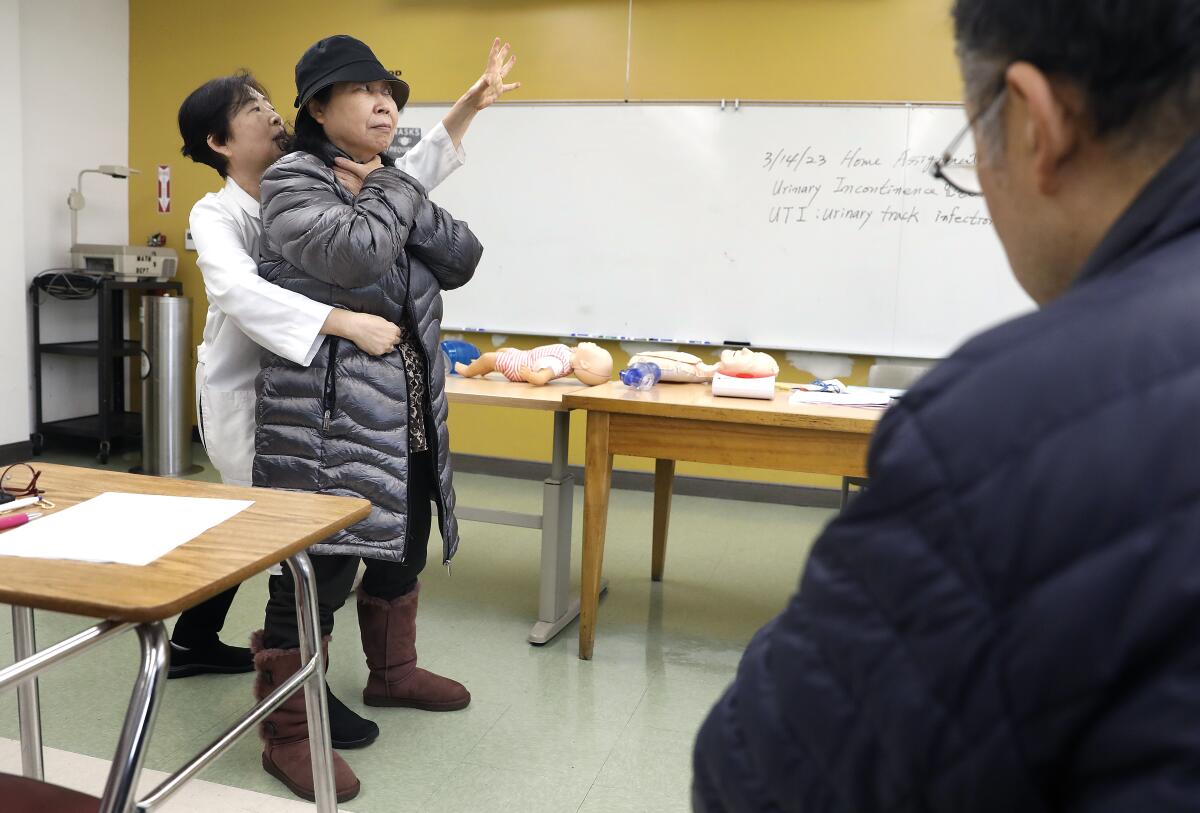
During a recent class in which students learned how to position clients so they don’t suffer from bed sores and muscle breakdowns, Cho worried she might not be able to find Korean-speaking clients where she lives.
Her professor, Helen Jang, quickly assured her, “If you knock, it will open.”
Jang, who has taught the course in Korean since 2010, said many students develop confidence by learning in their primary language. She also carves out time for students to reflect on the struggles they may share as immigrants.
“Whenever I have the chance, I let them express — living in America, how difficult it is,” she said. “I also want them to get healing … through this class.”
More to Read
Sign up for Essential California
The most important California stories and recommendations in your inbox every morning.
You may occasionally receive promotional content from the Los Angeles Times.













